
First up it’s pronounced Bresha. Get that right and people won’t look at you quite so oddly when you ask directions. Brescia is a town of 200,000 people at the foot of the Alps in northern Italy. Near the eastern Italian lakes, it is equidistant from Lake Garda and the smaller Lake Iseo, both of which are delightful – and add to the sense that there’s too much to see in this part of Italy. However long you stay you’ll wish you had longer, if only to keep eating the delicious local cheese.

Brescia only has a small airport, so most visitors by air arrive via Verona or Bergamo, both of which are an hour away. Brescia could be your base for visiting the clear Alpine lakes, but it also has treasures of its own that are worth seeing, as well as the relaxed Italian cafe culture that Anglo-saxons crave. The central Piazza Loggia dates from 1492 and is a great place for an aperitivo. It is an elegant Venetian square, reflecting the control that the Venetians had over Brescia for four centuries.

The name Brescia comes from the ancient Brixia, which became a Roman colony in 89BC. It was an important Cisalpine centre, passing through the hands of the Franks, the Lombards and the Visconti before becoming part of the Venetian Republic until 1797. Rebelling against Austrian rule in 1849 earned Brescia the nickname ‘Lioness of Italy’ and it was incorporated into the Kingdom of Italy in 1859.
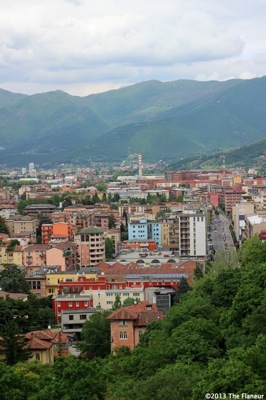
In the hope of saving lives I must say that Brescia does a nice line in streets that look pedestrianised but aren’t. Ornamental pot plants to the side, patterned bricks underfoot, people wandering all over the place between little boutiques and cafes. Then suddenly, from nowhere, a bus or a car. This chap is risking his life.

However once you get used to that the centro is a pleasant place to wander, with Renaissance piazzas, ancient ruins, churches and a Baroque cathedral. Where most towns make do with one cathedral Brescia has decided it needs two. Within a few metres of each other on Piazza Paolo VI are the Duomo Vecchio and the Duomo Nuovo. As is often the case, to 21st century eyes the older structure is the simpler, more elegant, whilst the later cathedral (built between 1604 and 1825) is a boisterous Baroque confection.
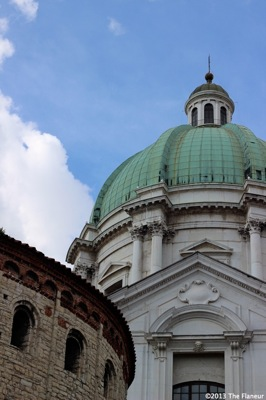
The old cathedral, known as the rotunda is a circular Romanesque building, built in the 11th century over the location of a previous basilica. Originally there was a tower over the West entrance, though that has collapsed. The new cathedral is on an altogether different scale.

As is the ancient temple on Via dei Musei, known as the Capitolium. In 2011 the complex of the San-Salvatore-Santa Giulia and the Capitolium were added to the UNESCO World Heritage list. The Capitolium can be seen from the street and taking the guided tour doesn’t allow you see a lot more. However the San Salvatore-Santa Giulia museum is a must see.
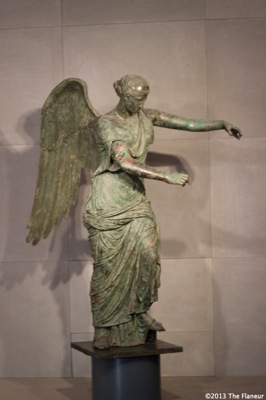
It houses many treasures, including the 9th century golden Cross of Desiderius studded with gems, and an ancient bronze statue of a winged Victory. It also includes the churches of San Salvatore and Santa Maria in Solario. The museum was built over an ancient Roman street and some of the museum rooms include Roman remains in situ.
Taking a leaf from Bologna’s book central Brescia has several porticoes which allow damp-free walking even when it is raining. It is well-known as a city of fountains – at the last count there were seventy-two. It is also a city of abstraction – the public services that are around all cities – bins, parking meters, etc are painted in abstract patterns.
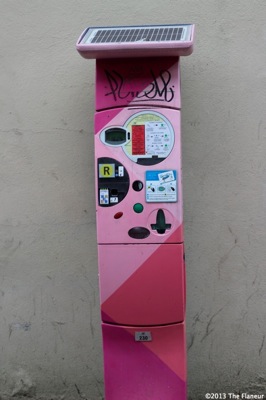
Brescia has so many churches that a separate map is published listing them all. One of the the most interesting is the simple and unadorned San Francesco d’Assisi on, would you believe the coincidence, Via San Francesco d’Assisi. This is one of the finest convent style churches in the whole of Italy. Finished in 1265 it is mainly late-Romanesque style. It has a delicate rose-window above the entrance that eschews the usual stained-glass whizz-bangery for gentle contemplation.
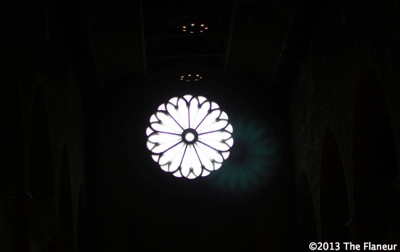
Of course Brescia is also the start and finish of the Mille Miglia, and is home to a museum celebrating the history of the race. Vintage cars galore fill the Monastery of Saint Eufemia, a few kilometres east of town. A beautifully restored building with a gleaming contents – you can’t miss the roundabout next to it.
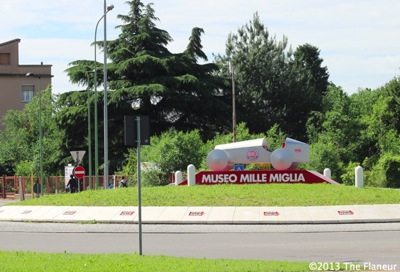
Back in town on Via Giuseppe Zanardelli is the Teatro Grande which is worth visiting if you like to spend your evenings in a neo-Baroque atmosphere. It puts on a varied programme of ballet, opera, concerts and theatre. More details on the current programme are available here.

Brescia is not one of Italy’s more famous cities. When people learn you are visiting Italy they usually say, ‘Oh, where about?’, expecting to be able to give their opinion on your destination. But Brescia more often elicits the response, ‘Oh, I haven’t been there.’ The centro has the usual charm of an Italian town. Local neighbours Verona and Milan attract more tourists so why not slip away to somewhere new and enjoy discovering this corner of Italy. It might be a small town, but with the Santa Giulia museum complex, the local Franciacorta wine and the views from the castle Brescia is worth a visit. It even has its own underground system!

Leave a Reply